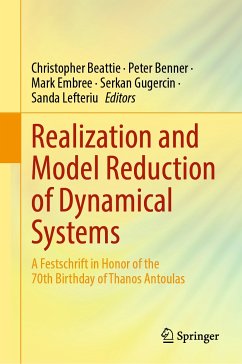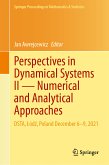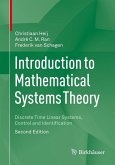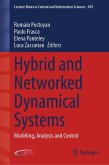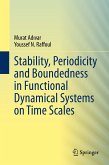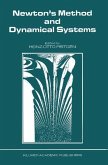Realization and Model Reduction of Dynamical Systems (eBook, PDF)
A Festschrift in Honor of the 70th Birthday of Thanos Antoulas
Redaktion: Beattie, Christopher; Lefteriu, Sanda; Gugercin, Serkan; Embree, Mark; Benner, Peter
-30%11
97,95 €
139,09 €**
97,95 €
inkl. MwSt.
**Preis der gedruckten Ausgabe (Gebundenes Buch)
Sofort per Download lieferbar

49 °P sammeln
-30%11
97,95 €
139,09 €**
97,95 €
inkl. MwSt.
**Preis der gedruckten Ausgabe (Gebundenes Buch)
Sofort per Download lieferbar
Alle Infos zum eBook verschenken

49 °P sammeln
Als Download kaufen

139,09 €****
-30%11
97,95 €
inkl. MwSt.
**Preis der gedruckten Ausgabe (Gebundenes Buch)
Sofort per Download lieferbar

49 °P sammeln
Jetzt verschenken
Alle Infos zum eBook verschenken
139,09 €****
-30%11
97,95 €
inkl. MwSt.
**Preis der gedruckten Ausgabe (Gebundenes Buch)
Sofort per Download lieferbar
Alle Infos zum eBook verschenken

49 °P sammeln
Realization and Model Reduction of Dynamical Systems (eBook, PDF)
A Festschrift in Honor of the 70th Birthday of Thanos Antoulas
Redaktion: Beattie, Christopher; Lefteriu, Sanda; Gugercin, Serkan; Embree, Mark; Benner, Peter
- Format: PDF
- Merkliste
- Auf die Merkliste
- Bewerten Bewerten
- Teilen
- Produkt teilen
- Produkterinnerung
- Produkterinnerung

Bitte loggen Sie sich zunächst in Ihr Kundenkonto ein oder registrieren Sie sich bei
bücher.de, um das eBook-Abo tolino select nutzen zu können.
Hier können Sie sich einloggen
Hier können Sie sich einloggen
Sie sind bereits eingeloggt. Klicken Sie auf 2. tolino select Abo, um fortzufahren.

Bitte loggen Sie sich zunächst in Ihr Kundenkonto ein oder registrieren Sie sich bei bücher.de, um das eBook-Abo tolino select nutzen zu können.
This book celebrates Professor Thanos Antoulas's 70th birthday, marking his fundamental contributions to systems and control theory, especially model reduction and, more recently, data-driven modeling and system identification. Model reduction is a prominent research topic with wide ranging scientific and engineering applications.
- Geräte: PC
- ohne Kopierschutz
- eBook Hilfe
- Größe: 11.82MB
Andere Kunden interessierten sich auch für
![Perspectives in Dynamical Systems II - Numerical and Analytical Approaches (eBook, PDF) Perspectives in Dynamical Systems II - Numerical and Analytical Approaches (eBook, PDF)]() Perspectives in Dynamical Systems II - Numerical and Analytical Approaches (eBook, PDF)153,95 €
Perspectives in Dynamical Systems II - Numerical and Analytical Approaches (eBook, PDF)153,95 €![Introduction to Mathematical Systems Theory (eBook, PDF) Introduction to Mathematical Systems Theory (eBook, PDF)]() Christiaan HeijIntroduction to Mathematical Systems Theory (eBook, PDF)36,95 €
Christiaan HeijIntroduction to Mathematical Systems Theory (eBook, PDF)36,95 €![Hybrid and Networked Dynamical Systems (eBook, PDF) Hybrid and Networked Dynamical Systems (eBook, PDF)]() Hybrid and Networked Dynamical Systems (eBook, PDF)97,95 €
Hybrid and Networked Dynamical Systems (eBook, PDF)97,95 €![Road Map for Sliding Mode Control Design (eBook, PDF) Road Map for Sliding Mode Control Design (eBook, PDF)]() Vadim UtkinRoad Map for Sliding Mode Control Design (eBook, PDF)53,95 €
Vadim UtkinRoad Map for Sliding Mode Control Design (eBook, PDF)53,95 €![Stability, Periodicity and Boundedness in Functional Dynamical Systems on Time Scales (eBook, PDF) Stability, Periodicity and Boundedness in Functional Dynamical Systems on Time Scales (eBook, PDF)]() Murat AdivarStability, Periodicity and Boundedness in Functional Dynamical Systems on Time Scales (eBook, PDF)89,95 €
Murat AdivarStability, Periodicity and Boundedness in Functional Dynamical Systems on Time Scales (eBook, PDF)89,95 €![Principles of Discontinuous Dynamical Systems (eBook, PDF) Principles of Discontinuous Dynamical Systems (eBook, PDF)]() Marat AkhmetPrinciples of Discontinuous Dynamical Systems (eBook, PDF)40,95 €
Marat AkhmetPrinciples of Discontinuous Dynamical Systems (eBook, PDF)40,95 €![Newton's Method and Dynamical Systems (eBook, PDF) Newton's Method and Dynamical Systems (eBook, PDF)]() Newton's Method and Dynamical Systems (eBook, PDF)113,95 €
Newton's Method and Dynamical Systems (eBook, PDF)113,95 €-
-
-
This book celebrates Professor Thanos Antoulas's 70th birthday, marking his fundamental contributions to systems and control theory, especially model reduction and, more recently, data-driven modeling and system identification. Model reduction is a prominent research topic with wide ranging scientific and engineering applications.
Dieser Download kann aus rechtlichen Gründen nur mit Rechnungsadresse in A, B, BG, CY, CZ, D, DK, EW, E, FIN, F, GR, HR, H, IRL, I, LT, L, LR, M, NL, PL, P, R, S, SLO, SK ausgeliefert werden.
Produktdetails
- Produktdetails
- Verlag: Springer International Publishing
- Seitenzahl: 460
- Erscheinungstermin: 9. Juni 2022
- Englisch
- ISBN-13: 9783030951573
- Artikelnr.: 64164813
- Verlag: Springer International Publishing
- Seitenzahl: 460
- Erscheinungstermin: 9. Juni 2022
- Englisch
- ISBN-13: 9783030951573
- Artikelnr.: 64164813
- Herstellerkennzeichnung Die Herstellerinformationen sind derzeit nicht verfügbar.
Christopher Beattie is Professor of Mathematics at Virginia Polytechnic Institute and State University. His areas of specialization are model reduction, computational linear algebra, spectral/eigenvalue estimation, numerical analysis, and scientific computing. Peter Benner is Director and Scientific Member of the Max Planck Institute for Dynamics of Complex Technical Systems in Magdeburg, a Professor for Mathematics in Industry and Technology at TU Chemnitz, and Honorary Professor at the Department of Mathematics, Otto-von-Guericke University, Magdeburg. His research areas include model reduction, systems and control theory, numerical linear and multilinear algebra, PDE-constrained optimization, and uncertainty quantification. Mark Embree is Professor of Mathematics at Virginia Polytechnic Institute and State University. With Nick Trefethen, he is co-author of Spectra and Pseudospectra: The Behavior of Nonnormal Matrices and Operators. His research interests include computational linear algebra and spectral perturbation theory. Serkan Gugercin is Professor of Mathematics at Virginia Polytechnic Institute and State University. His research interests are model reduction, systems and control theory, data-driven modeling, and numerical analysis. Sanda Lefteriu is Associate Professor at IMT Lille Douai. Her research areas include model reduction, black-box and grey-box modeling of dynamical systems with various engineering applications.
Part I: Linear Dynamical Systems: B. Joseph, The rational interpolation problem: Grassmannian and Loewner-matrix approaches.- B. Jean-Paul, The conditioning of a linear barycentric rational interpolant.- D. Zlatko, Learning low-dimensional dynamical-system models from noisy frequency-response data with Loewner rational interpolation.- E. Mark, Pseudospectra of Loewner Matrix Pencils.- R. Paolo, A Loewner matrix approach to the identification of linear time-varying systems.- V. D. Paul, Linear System Matrices of Rational Transfer Functions.- Part II: Nonlinear Dynamical Systems: C. Xingang, Interpolation-based Model Order Reduction for Quadratic-Bilinear Systems and H2 Optimal Approximation.- C. Sridhar, An Adaptive Sampling Approach for the reduced basis method.- K. Boris, Balanced Truncation Model Reduction for Lifted Nonlinear Systems.- L. Sanda, Modeling the buck converter from measurements of its Harmonic Transfer Function.- P. Mihaly, Model reduction and realization theory oflinear switched systems.- Part III: Structured Dynamical Systems: F. F. Damasceno, Developments in the Computation of Reduced Order Models with the Use of Dominant Spectral Zeros.- M. Volker, Structure-preserving Interpolatory Model Reduction for Port-Hamiltonian Differential-Algebraic Systems.- P. D. Igor, Data-Driven Identification of Rayleigh-Damped Second-Order Systems.- S. Tatjana, Balanced truncation model reduction for 3D linear magneto-quasistatic field problems.- Van der S. Arjan, Structure-preserving model reduction of physical network systems.- Part IV: Model Reduction for Control: B. Tobias, H2-gap model reduction for stabilizable and detactable systems.- H. Matthias, Reduced Order Model Hessian Approximations in Newton Methods for Optimal Control.- P.-V. Charles, Interpolation-based irrational model control design and stabilty analysis.- Part V: Applications: D. Clifford, Oscillations in Biology: G. Eduardo, Model-Order Reduction for Coupled Flow andLinear Thermal-Poroplasticity with Applications to Unconventional Reservoirs.- I. Roxana, Challenges in model reduction for real-time simulation of traction chain systems.- N. Masaaki, Sparse Representation for Sampled-data Hinf Filter.- S. Eduardo, Analysis of a reduced model of epithelial-mesenchymal fate determination in cancer metastasis as a singularly-perturbed monotone system.
Part I: Linear Dynamical Systems: B. Joseph, The rational interpolation problem: Grassmannian and Loewner-matrix approaches.- B. Jean-Paul, The conditioning of a linear barycentric rational interpolant.- D. Zlatko, Learning low-dimensional dynamical-system models from noisy frequency-response data with Loewner rational interpolation.- E. Mark, Pseudospectra of Loewner Matrix Pencils.- R. Paolo, A Loewner matrix approach to the identification of linear time-varying systems.- V. D. Paul, Linear System Matrices of Rational Transfer Functions.- Part II: Nonlinear Dynamical Systems: C. Xingang, Interpolation-based Model Order Reduction for Quadratic-Bilinear Systems and H2 Optimal Approximation.- C. Sridhar, An Adaptive Sampling Approach for the reduced basis method.- K. Boris, Balanced Truncation Model Reduction for Lifted Nonlinear Systems.- L. Sanda, Modeling the buck converter from measurements of its Harmonic Transfer Function.- P. Mihaly, Model reduction and realization theory oflinear switched systems.- Part III: Structured Dynamical Systems: F. F. Damasceno, Developments in the Computation of Reduced Order Models with the Use of Dominant Spectral Zeros.- M. Volker, Structure-preserving Interpolatory Model Reduction for Port-Hamiltonian Differential-Algebraic Systems.- P. D. Igor, Data-Driven Identification of Rayleigh-Damped Second-Order Systems.- S. Tatjana, Balanced truncation model reduction for 3D linear magneto-quasistatic field problems.- Van der S. Arjan, Structure-preserving model reduction of physical network systems.- Part IV: Model Reduction for Control: B. Tobias, H2-gap model reduction for stabilizable and detactable systems.- H. Matthias, Reduced Order Model Hessian Approximations in Newton Methods for Optimal Control.- P.-V. Charles, Interpolation-based irrational model control design and stabilty analysis.- Part V: Applications: D. Clifford, Oscillations in Biology: G. Eduardo, Model-Order Reduction for Coupled Flow andLinear Thermal-Poroplasticity with Applications to Unconventional Reservoirs.- I. Roxana, Challenges in model reduction for real-time simulation of traction chain systems.- N. Masaaki, Sparse Representation for Sampled-data Hinf Filter.- S. Eduardo, Analysis of a reduced model of epithelial-mesenchymal fate determination in cancer metastasis as a singularly-perturbed monotone system.
